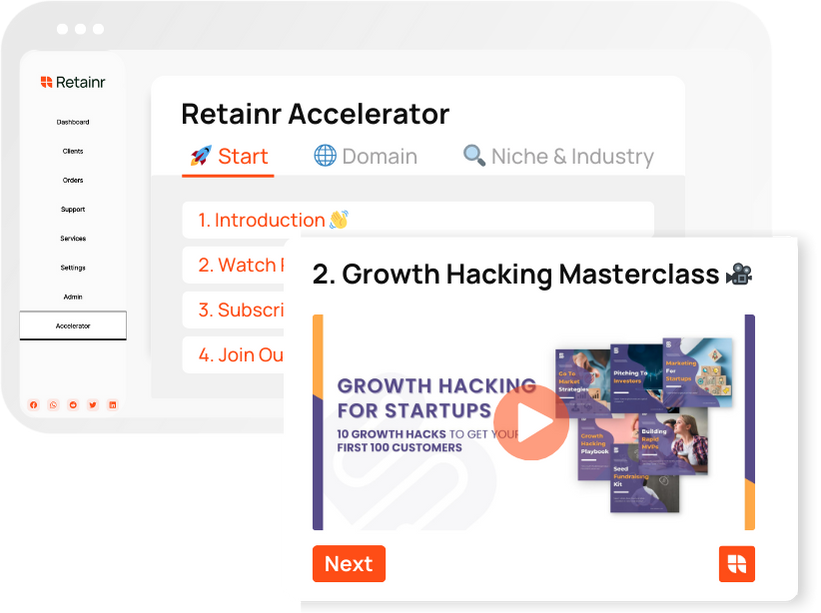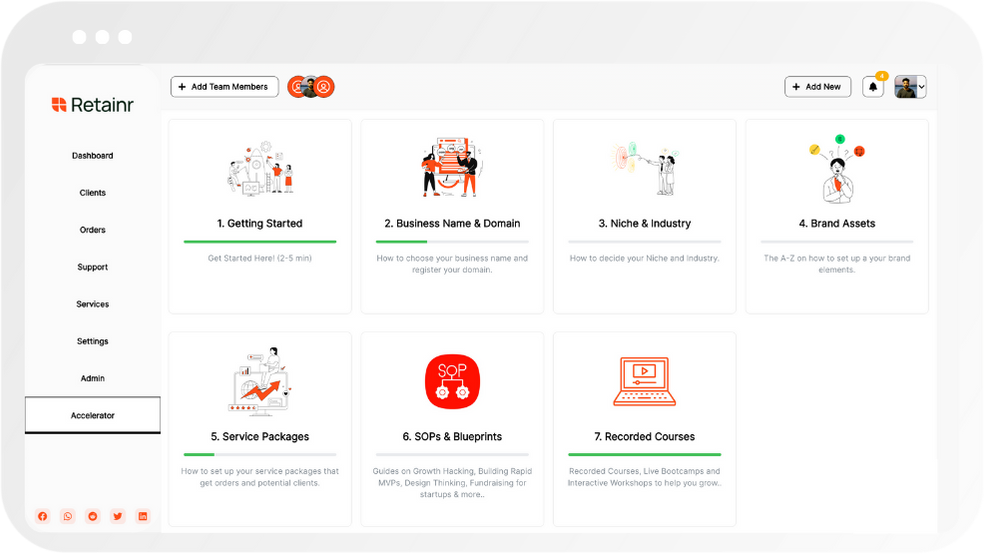
Top 10 Metrics to Measure Project Portfolio Management Success
Build with Retainr
Sell your products and services, manage clients, orders, payments, automate your client onboarding and management with your own branded web application.
Get Started1. What are the top 10 metrics to measure project portfolio management success?
Important Metrics for Project Portfolio Management Success
Project Portfolio Management (PPM) success is fundamentally based on the ability of the organization to achieve its strategic goals and objectives. This involves a comprehensive evaluation of the projects in the portfolio against particular metrics that demonstrate progress, productivity, and profitability. Therefore, a robust measurement system is crucial to ascertain if the portfolio is driving the expected value and benefits to the organization.
List of Top 10 PPM Success Metrics
- Strategic Alignment - How well projects align with the organizational strategy.
- Financial Performance - ROI, NPV, and profitability index.
- Resource Utilization - Maximize resource usage to achieve efficiency.
- Risk Management Efficiency - How well risks are identified and mitigated.
- Project Performance - Adherence to schedule, budget and scope.
- Stakeholder Satisfaction - Meeting or exceeding stakeholder expectations.
- Benefits Realization - Tracking the realization of projected benefits.
- Change Management - Effectiveness in managing organizational change.
- Innovation Impact - Contributions to innovation in the organization.
- Operational Efficiency - Overall effectiveness in operations.
Table Representation of Metrics
| Metric | Description |
|---|---|
| Strategic Alignment | Ensures projects are contributing to the strategic goals of the organization. |
| Financial Performance | Provides analysis on profitability, ROI and NPV. |
| Resource Utilization | Assesses how resources are deployed and used. |
| Risk Management Efficiency | Evaluates the mitigation of potential risks. |
| Project Performance | Monitors project progress against the defined schedule, budget, and scope. |
2. How does ROI factor into measuring project portfolio management success?
ROI and Project Portfolio Management
Return on Investment (ROI) is a significant metric in measuring the success of Project Portfolio Management (PPM). PPM success isn't merely about launching projects on time and within budget, but also about ensuring the projects yield beneficial financial results, hence the centrality of ROI calculations. This financial metric illustrates the efficiency and profitability of an investment, which can help managers decide which projects to prioritize.
ROI Calculation
ROI is calculated by subtracting the project cost from the project benefits and then dividing the result by the project cost. This gives a percentage that can be used to compare returns across multiple projects or investment opportunities:
ROI = (Gain from Investment - Cost of Investment) / Cost of Investment
| Information | Example |
|---|---|
| Cost of project | $500,000 |
| Projected financial benefits | $700,000 |
| ROI Calculation: | ($700,000 - $500,000)/$500,000 = 0.4 or 40% |
From the above, if the ROI of a project is 40%, that would mean for every dollar invested, the company stands to make a 40-cent return.
The Significance of ROI in PPM
ROI plays a crucial role in PPM because it enables business managers to:
- Assess the profitability: ROI provides an overview of the profitability of a project, which in turn helps determine whether the project is worth pursuing.
- Prioritize projects: By calculating and comparing ROI of different projects within the portfolio, it helps in effectively prioritizing the projects depending on the value each can bring to the organization.
- Measure success over time: Continuous tracking and calculation of ROI post-project completion can provide insights on how well the project is performing.
3. How can I measure the strategic alignment of my project portfolio?
Ways to Measure the Strategic Alignment of Your Project Portfolio
Strategic alignment ensures that the projects within your portfolio contribute towards the achievement of business objectives. To measure this alignment, you can use a variety of metrics which include:
- Strategic value score: Each project is given a score based on the projected contribution to strategic goals. Higher scoring projects are more aligned with the business strategy.
- Percentage of projects in line with business objectives: This provides an overview of the overall portfolio’s alignment with strategy.
- Strategy achievement potential: Measures the potential impact of individual projects on strategic objectives.
Implementing Measurement Tools
Once you have defined your metrics, it's crucial to implement proper tools to track them over time. These might include Project Portfolio Management (PPM) tools, Balanced Scorecard, or Strategy Map. These tools should provide visualizations, timelines, and data insights to help track progress towards strategic alignment.
Benchmarking Strategic Alignment
After measuring the strategic alignment, it's also beneficial to benchmark your results against industry standards. This will give you an insight into your performance relative to your competitors. A simple table showing your alignment score against the industry average could look like this:
| Your portfolio alignment score | Industry average score |
|---|---|
| 85% | 75% |
4. In what way does risk management metrics help in project portfolio success?
Risk Management Metrics Importance
Risk management is a vital process that allows project managers to proactively identify, analyze, and mitigate potential risks and uncertainties that could impact the project negatively. Risk management metrics are used to measure and quantify the effectiveness of risk management strategies and practices in the project portfolio. They help project managers continuously monitor and track risks, and make informed decisions when adjustments are needed to ensure project success.
Effective Risk Management Metrics
Effective risk management metrics include 'Risk Exposure', 'Risk Severity', 'Risk Velocity', 'Risk Vulnerability', and 'Risk Impact'.
- Risk Exposure: This represents the potential loss (in terms of time, cost, and quality) that could be incurred if a particular risk materializes.
- Risk Severity: This metric measures the potential impact of a risk on the project's objectives if it occurs.
- Risk Velocity: This reflects how quickly a risk could impact the project after it is identified.
- Risk Vulnerability: This measures a project's susceptibility to specific risks.
- Risk Impact: This is an estimate of the potential effects (positive or negative) of a risk on the project's goals.
Benefits of Risk Management Metrics
By implementing and monitoring these risk management metrics, project managers can gain several benefits.
| Benefit | Description |
|---|---|
| Improved Decision-making | Risk management metrics provide quantitative data which helps in making objective and informed decisions. |
| Proactive Risk Mitigation | By continuously monitoring these metrics, potential risks can be identified and mitigated before they become issues. |
| Increased Project Success | Effective risk management ensures that risks are managed properly, which increases the chances of project success. |
5. What is resource utilization and how does it contribute to project portfolio success?
Understanding Resource Utilization
Resource Utilization refers to the process of managing and allocating a company's resources in a way that maximizes efficiency, productivity, and profitability. Resources could range from personnel, materials, and technology to time and money. It is a key performance indicator or metric in project portfolio management since it indicates the percentage of total company resources that are currently being used in various projects.
Measuring Resource Utilization
The most basic way to measure resource utilization is by comparing the number of hours a resource was actually worked against what is available. It is usually expressed in percentage form.
| Resource | Hours Worked | Hours Available | Resource Utilization (%) |
|---|---|---|---|
| Employee A | 40 | 50 | 80% |
| Employee B | 50 | 50 | 100% |
Resource Utilization's Contribution to Project Portfolio Success
Effective resource utilization contributes significantly to project portfolio success in several ways. Firstly, it ensures all resources are used in the most efficient and productive way, eliminating unnecessary costs and maximizing return on investment. Secondly, it aids in capacity planning, helping the organization to meet its commitments and deadlines more accurately. Lastly, it helps in prioritizing projects according to their resource needs and the availability of those resources, thereby reducing project risks and improving the project success rate.
- Efficiency: Maximizes the use of resources, reducing waste.
- Capacity planning: Helps in workload balance and avoiding over/under-utilization.
- Prioritizing projects: Ensures resources are directed towards projects that need them most and can deliver the highest returns.
6. How can we measure project performance within project portfolio management to ensure success?
Measuring Project Performance in Project Portfolio Management
Measuring project performance within project portfolio management involves a composite score of several key performance indicators (KPIs). These KPIs can vary across portfolios but often include factors such as financial performance, meeting project deadlines, and adherence to budget. For success, we need to continuously monitor these metrics, adjust them based on the organisation's changing priorities, and take corrective action when necessary. Here are three common metrics:
- ROI (Return on Investment): This is a primary measure of project success and a key metric in portfolio management. It indicates the amount of return on an investment relative to its cost. Mathematically, it's the ratio of net profit to the cost of investment.
- Project Completion Rate: This measures the number of projects that has been completed on time. A high rate of timely project completion is an indicator of good project management and coordination process.
- Budget Variance: This compares the approved budget for the project against what is actually spent. This gives an idea of financial efficiency and is useful for predicting future financial needs.
For a more detailed view, you may also consider metrics such as strategic alignment, risk mitigation success, resource utilization, stakeholder satisfaction and the quality of delivered projects. Each of these aspects can be summarised in a project performance scorecard. Here is an example:
| Metric | Measure | Weightage |
|---|---|---|
| ROI | Net Profit / Cost of Investment | 20% |
| Project Completion Rate | No. of On-time Projects / Total No. of Projects | 20% |
| Budget Variance | (Budgeted Cost - Actual Cost) / Budgeted Cost | 20% |
| Strategic Alignment | Qualitative assessment based on alignment with business goals | 20% |
| Risk Mitigation Success | Qualitative assessment based on risk handling | 10% |
| Resource Utilization | Resources Used / Total Resources Available | 10% |
7. For project portfolio management, what is the significance of measuring stakeholder satisfaction?
Significance of Measuring Stakeholder Satisfaction
Measuring stakeholder satisfaction is a crucial aspect of Project Portfolio Management (PPM). A project's success doesn't only rely on traditional metrics like time, cost, and quality but also how well it satisfies the needs and expectations of its stakeholders. Understanding their satisfaction helps the management team gain feedback on their performance and readjust their strategies if needed. It sets the foundation for future engagements and can potentially lead to more opportunities.
- Fosters Stakeholder Engagement: A high stakeholder satisfaction indicates an effective engagement strategy, which can influence a project's overall success. Fostering positive relationships and effective communication channels can actively involve stakeholders, driving the project towards its objectives.
- Influences Project Decisions: Accurate measurement of stakeholder satisfaction can also influence project decisions. Stakeholder analysis can lead to valuable insights, which can assist with risk management, planning, and decision-making processes.
- Improves Performance: The measurement of stakeholder satisfaction provides tangible feedback on how well the project is being managed. This insight can motivate improvements in project performance and drive innovation and change where necessary.
| Metric | Description |
|---|---|
| Stakeholder Engagement | This metric indicates how active and involved the stakeholders are in the project. High engagement suggests a strong relationship and clear communication between stakeholders and the project team. |
| Influence on Decisions | This reflects the impact of the stakeholders' insights and perspectives on the project's decision-making processes. Frequent influence suggests strong stakeholder involvement and a democratic decision-making process. |
| Performance Improvement | This signifies how stakeholder feedback has led to changes and improvements within the project. Regular improvement based on feedback indicates proactive project management and a commitment to stakeholder satisfaction. |
In conclusion, stakeholder satisfaction is a prevalent metric in PPM, consistently underpinning the decisions and direction of a project. Measuring it accurately can provide practical insights that help a project meet or exceed its objectives, fostering a stronger relationship with stakeholders, and driving overall project success.
8. Can I quantify or measure the innovation in my project portfolio? How does it influence the success of project portfolio management?
Quantifying Innovation in Project Portfolio
Yes, innovation can be quantified and measured within a project portfolio. It is an essential metric for success as it ensures the project portfolio remains competitive and relevant over time. One method to gauge innovation is through the 'Innovation Index'. This metric involves counting the number of new products, services, or processes introduced within a projects' lifecycle and calculating their contribution to the overall portfolio performance. The larger the index, the higher the innovation.
Innovation Index Table
| No. | Project | New Products/Services/Processes | Contribution to Portfolio |
|---|---|---|---|
| 1 | Project 1 | 3 | 15% |
| 2 | Project 2 | 2 | 10% |
Influence of Innovation on Portfolio Management Success
Innovation has a significant influence on the success of project portfolio management. Firstly, it promotes growth by opening up new markets and opportunities. Secondly, it enhances efficiency by encouraging the implementation of new processes or technologies. Lastly, innovation increases project value by differentiating the portfolio from competition and ensuring its sustained relevance. By measuring and tracking innovation, an organization can gradually improve its innovation capability and consequently, its project portfolio success.
9. How do you calculate cost variance and why is it a key metric in project portfolio management?
Calculating Cost Variance
Cost Variance (CV) is an essential metric in project portfolio management as it measures the difference between the estimated budget (planned value) of the project and the actual cost. To compute CV, subtract the actual cost (AC) from the earned value (EV) of the project. Mathematically, it can be written as CV = EV – AC.
- EV (Earned Value): It is the budgeted amount for the tasks which have already been completed.
- AC (Actual Cost): It refers to what you have really expended on the finished tasks.
Importance of Cost Variance
Cost variance supplements pivotal insights about the financial performance of the project portfolio. It aids in indicating whether the projects within the portfolio are under-budget, over-budget, or on-target. Below is a table representation of the possible Cost Variance values.
| Cost Variance (CV) | Project Status |
|---|---|
| CV > 0 | Project is under-budget |
| CV = 0 | Project is on-budget |
| CV < 0 | Project is over-budget |
Key Metric in Project Portfolio Management
Cost variance provides a quantitative method to gauge the project's financial effectiveness. A positive CV implies the project is under budget, while a negative CV implies the project is over budget. This enables project managers to take corrective actions in a timely manner. Given its vital role in maintaining project profitability, measuring cost variance is a must in project portfolio management.
10. How can the financial health of a project portfolio be measured, and why is this metric significant for portfolio success?
Measuring Financial Health of a Project Portfolio
The financial health of a project portfolio can be quantified using various key financial metrics. Some of them include:
- Return on Investment (ROI) - This metric reflects the profitability of the projects in the portfolio in relation to their costs.
- Net Present Value (NPV) - NPV aids in evaluating the profitability of a project in the long-run by factoring in the time value of money.
- Profit Margin - Profit margin measures the amount by which revenue from sales exceeds costs in a project.
Significance of Financial Health Metric
The financial health of a project portfolio is a critical metric as it gives a snapshot of the portfolio's profitability and overall performance. It provides invaluable insights into how efficiently resources are being utilized and whether the projects are meeting their respective financial objectives. By efficiently tracking and managing these financial metrics, organizations can ensure that they are investing in the right projects and thereby maximizing their portfolio's value.
Illustrating Financial Health using a Table
The table below offers a summary of the aforementioned financial metrics for a hypothetical project portfolio:
| Project Name | ROI | NPV | Profit Margin |
|---|---|---|---|
| Project A | 20% | $10,000 | 25% |
| Project B | 15% | $5,000 | 30% |
| Project C | 25% | $15,000 | 35% |
Conclusion
Key Metrics for Project Portfolio Management Success
Effective management of a project portfolio is paramount for success in any business. The ability to track, measure, and evaluate performance is crucial, making specific metrics instrumental in assessing management success. Here are the ten most crucial metrics.
1. Strategic Alignment
This refers to the degree at which a project aligns with the organisation’s overall strategy and goals.
2. Financial Performance
This includes metrics such as Net Present Value (NPV), Return on Investment (ROI), and payback period.
3. Risk Management
This measures how well potential risks are identified and mitigated within the portfolio.
4. Resource Utilisation
This metric indicates whether resources are being used optimally or there are areas of overspending or underspending.
5. Stakeholder Satisfaction
An indicator of how satisfied stakeholders are with the portfolio’s performance and outputs.
6. Project Delivery Success
This measures how successfully projects within the portfolio are delivered on time, within budget, and fulfilling the scope.
7. Benefits Realisation
This assesses the actual benefits derived from the portfolio compared to the expected benefits.
8. Portfolio Balance
This reflects the diversity of projects in the portfolio, ensuring a mix of short-term and long-term projects, differing levels of risk, and different types of expected benefits.
9. Portfolio Value
This is the aggregated value generated by all projects within the portfolio.
10. Portfolio Health
This measures the overall condition of the project portfolio, considering all other metrics.
All these metrics are essential, but what makes them more efficient and practical is having software, like Retainr.io, to help manage and visualize these measurements. Retainr.io is an innovative white-label software that allows businesses to handle their clients, orders, payments, and pretty much the entirety of their operations. So, give your business a boost. Elevate your project portfolio management with Retainr.io.
Boost Your Agency Growth
with Retainr Accelerator
Uncover secrets, strategies, and exclusive blueprints to take your agency's growth to the next level — from marketing insights to effective presentations and leveraging technology.

SOPs, Cheatsheets & Blueprints
Leverage 50+ SOPs (valued over $10K) offering practical guides, scripts, tools, hacks, templates, and cheat sheets to fast-track your startup's growth.
Connect with fellow entrepreneurs, share experiences, and get expert insights within our exclusive Facebook community.
.jpg)

Join a thriving community of growth hackers. Network, collaborate, and learn from like-minded entrepreneurs on a lifelong journey to success.

Gain expertise with recorded Courses, Live Bootcamps and interactive Workshops on topics like growth hacking, copywriting, no-code funnel building, performance marketing and more, taught by seasoned coaches & industry experts.

.jpg)

.jpeg)


